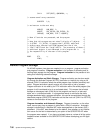With the exception of the Get Client Handle API, which is available only through the
Integrated Language Environment (ILE), the client software management and con-
figuration APIs are available as both the original program model (OPM) and ILE
APIs.
Add Client (QZCAADDC, QzcaAddClient) API
To manage a client one must keep track of all clients on the network. This API
provides a convenient way of keeping track of clients. By calling this API, a
client is added to the database. If a client is SNMP-enabled and is set up in
such a way so as to send traps to the managing AS/400, the client is automat-
ically added to the AS/400 database. This API provides a way to add clients
that may not be SNMP-enabled.
Remove Client (QZCARMVC, QzcaRemoveClient) API
This API provides a way to remove a client from the database for a client that
is no longer required to be managed.
Refresh Client (QZCAREFC, QzcaRefreshClientInfo) API
If a client is SNMP-enabled, this API makes an attempt to get hardware and
software information from this client. Hardware information is retrieved from the
host resource management information base (MIB), and software information is
retrieved from both the Desktop Management Interface (DMI) and the host
resource MIB.
This information is also retrieved automatically when traps are received on the
managing AS/400 from its clients. Therefore, this API provides a way to force
a “refresh” of client information to keep information current.
Update Client Information (QZCAUPDC, QzcaUpdateClientInfo) API
This API provides a way to update a few fields that are not updated with the
Refresh Client API.
Get Client Handle (QzcaGetClientHandle) API
This API returns a handle, which is unique for every client known to AS/400.
As mentioned earlier, the interface to this API is only provided through a
service program.
Communications APIs
The user-defined communications APIs were created to provide users with the
ability to develop their own high-level communications protocol with as little system
interference as possible. While the system manages the lower-level protocol, the
user develops the upper layers of a protocol in any high-level programming lan-
guage supported by the AS/400. Several lower-level protocols are supported
including X.25, Ethernet Version 2, IEEE Ethernet, token ring, and fiber distributed
data interface (FDDI) (the selection of which is chosen by the user).
The APIs provide the ability to enable a link (that is, line, controller, and device),
disable a link, establish inbound routing information by setting service access points
(that is, filters), transmit and receive data, set timers, and query line descriptions.
The user-defined communications APIs are used primarily by users who have com-
munications needs not normally associated with the other existing communications
protocols, namely TCP/IP, SNA, or OSI. Applications that have been developed
8-2 System API Programming V4R1


















